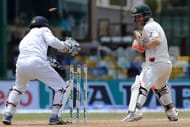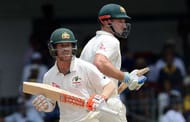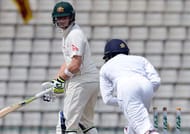Cricket has increasingly become a game of home advantage. Teams make best use of home conditions, even as they find the going tough overseas. The ever dominant Aussies too have had their share of issues in the Indian subcontinent recently.
At the end of the tour of Sri Lanka, Australia had lost 13, drawn 4 and won just 1 of the 18 Tests played in the subcontinent since 2008. In Allan Border’s reign, the Aussies won only 2 of 22 Tests in Asia, and this recent performance is only a continuation of a history of non-performance; a period in the early 2000s when they won 10 out of the 12 Tests under Ricky Ponting and Adam Gilchrist being an aberration.
However, this 3-0 clean sweep of the Aussies by a rebuilding Lankan team, only their second series defeat in the island nation, asks pressing questions of the former’s preparation ahead of the gruelling Indian summer.
Let’s have a glance at their top 5 weaknesses in the subcontinent:
#5 Faulty Batting Technique
Their major headache in the subcontinent almost entirely revolves around their batting travails against quality spin bowling. With technique suited to playing spin on wickets back home, providing true bounce and turn, Aussie batsmen in general, are at sea against variations of turn, bounce, trajectory and pace offered by dry turners in this part of the world.
Amongst the many Aussie batsmen who couldn’t weather the sub-continental conditions, Damien Martyn, a key figure in their historic series victories in India and Sri Lanka, was probably an exception. On several occasions during the just concluded Test series in Lanka, they were guilty of either planting their foot in the line of the ball, playing inside the line fending at deliveries spinning away or playing away from the body leaving bat-pad gap.
The height of wrong judgement was their indecision, even against the ball that goes on straight; the defining moment being Usman Khawaja’s generous leave to a ball from Dilruwan Perera that kept its line and picked his off peg in the 2nd innings of the 2nd Test at Galle.
With testing times ahead against India, the sooner their batsmen reorganise their technique, specifically to smother the sub-continental challenge, better their chances.
#4 Unequipped Spin Attack
Out of the 60 Aussie wickets that fell in the Sri Lanka series, 54 were picked by the spinners, with Rangana Herath leading the way with 28 and ably supported by Dilruwan Perera and Lakshan Sandakan with 15 and 9 wickets respectively.
In contrast, Aussies picked 58, of which Starc alone accounted for 24. Every time the Aussies have toured the subcontinent, their spinners have failed to perform on par with those of the opposition.
Moreover, spin has never been top on the list of worries for the sub-continental batsmen, who have been brought up playing spin in these conditions. That is evinced by the fact that even the greatest of them, Shane Warne, has had a rough outing in India where he averaged a paltry 43.11
As crucial as it is for batsmen, bowlers too have to adapt their bowling styles to extract best out of these conditions. In a recent interview, Nathan Lyon had himself acknowledged that the subcontinent method of spin bowling where the bowler undercuts across the ball rather than over the seam was a skill that Aussie spinners were yet to acquire.
#3 Team Combination
Are the Aussies picking the right men for the challenge, is an important question to ask. Given the ease with which sub-continental batsmen play the less threatening Aussie spinners, would it have been better if the Aussies stuck to their strengths – that is their pace attack rather than their less than impressive spinners?
In Mitchell Starc and Josh Hazlewood, they have a bowling pair that is capable of running through batting line-ups regardless of conditions.
The addition of an attacking wrist spinning option in Adam Zampa, though, may add more variety to the bowling. They also ought to pick batsmen who are well equipped to face spin in the subcontinent.
On the tour of Sri Lanka, Shaun Marsh, a good player of spin who has to his credit a century on Test debut in Sri Lanka, had to wait till the final Test for his opportunity. He showed what he is capable of by scoring a century and ended up scoring more runs in 2 innings than managed by some of his mates in 6 innings on the tour.
#2 Test of Temperament
Batting in the subcontinent is not merely about proper technique but also about the right temperament. Elsewhere, batsmen see through the initial nervy moments and capitalise once the ball gets older. On a dry turner, the possibility of dismissal is always relentless.
A batsman is never ‘in’ on such a surface and has to be alert in defence and judicious in attack. The brisk scoring Aussie batsmen often try to take the attack to the bowler in order to unsettle his rhythm. However, batting on the subcontinent is more a test of patience than assertive stroke play.
Batsmen who revel here are those who patiently bide time and seize the right moment to attack. Yet, many of the younger generation Aussie batsmen seem to trust their defence lesser and when cornered, employ the sweep or try to step out as a counter-attack, only to play around the wrong line and length of the ball.
Even Steven Smith was guilty of the same when he ran down the pitch to a wide, flighted delivery from Herath in just the 2nd over of Day 2 of the 1st Test at Pallekalle, only to miss a wild heave and be stumped.
#1 Big Guns Don’t Fire
Australia needs its experienced senior guys to step up with some inspiring performances in tough circumstances. Stats till date reveal otherwise. Steven Smith, David Warner and Nathan Lyon, in no particular order, are key members who haven’t performed to their potential in Asian conditions.
Warner’s overall average of 48.63 drops to 33.16 in Asia and he has scored only a solitary century in 18 innings. Smith’s spectacular average of 58.55 also sees a similar dip to 41.57 in Asia; an improvement from less than 38 before his century in the 3rd Test at Colombo, which also happens to be his first in Asia.
Lyon, who has in all fairness, done a fair job as their premier spinner in the post-Warne era, has a shoddy average to his credit in Asia.
A respectable overall average of 32.8 shoots up to 42.57 in Asia. Worse, he leaks runs at close to 4 an over. Add to the fact that he also bowls a large share of the overs, it indicates that through him, Australia has failed to keep opposition batsmen under control.
Come the tour of India, they will hope that these three can change its sagging fortunes in Asia.
Looking for fast live cricket scores? Download CricRocket and get fast score updates, top-notch commentary in-depth match stats & much more! 🚀☄️






